Nundroo 152km, 95mi *
At 18.9kmph this was my slowest riding day. When I left Nullarbor at 6:45AM there was already a moderate headwind. It was overcast (good) and cool (good). Going past the mileage sign I was only able to cruise comfortably at 20kph, in the aerobars.
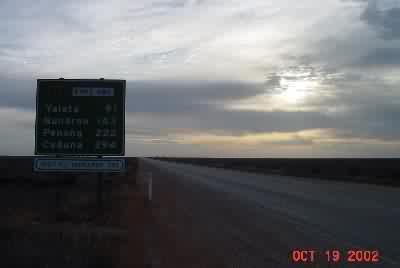
The wind didn’t overly concern me because as the sign indicates, I had lots of choices for the day. I wanted Ceduna, but would have settled for Penong. For the next couple hours as I struggled through vast open plains with ever building winds at 15kmph, I was thinking I would stay at Yalata, the only Aboriginal Roadhouse.
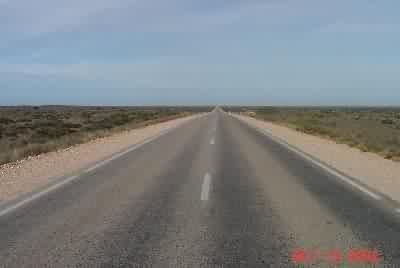
That’s what riding into a headwind looks like. An hour or two down the road I came to a famous sight, the Head of the Bight. It would have been a 24km round trip detour. Anyway, it was closed that early in the morning (the Yalata Community collects a ‘whale watching fee’ to go to the coast here), so I stayed low – while the wind blocked out all other sounds, including traffic. I did look up and notice a road train heading for me, in my lane, with his lights and flashers on – in enough time to pull over and snap this picture.
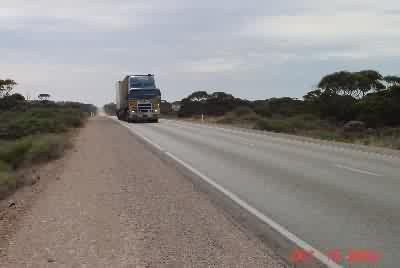
He was passing another road train, a feat that takes kilometers. I needed my morning (10:30A break) and was looking for some point of reference when I came upon Emergency Phone 1, with a little map.
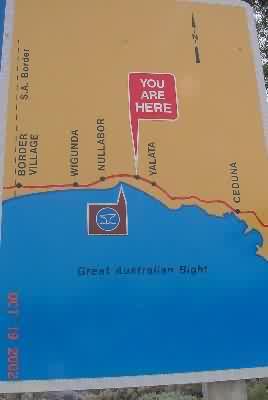
I am where it says “You are Here”. Without any significant transition, the terrain had changed from flat and treeless to hills and little forests.
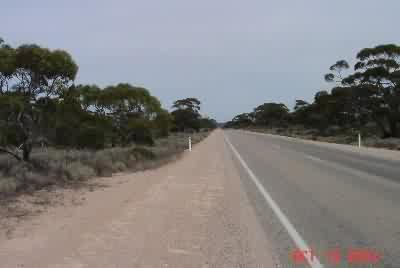
The combination of the trees and hills provided some respite from the wind. I was, and signs like this kept reminding me all day, passing through Aboriginal land.
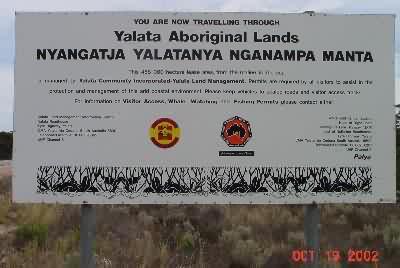
The map had this comment: “No alcohol is allowed on Yalata Aboriginal Lands. The Yalata Community would prefer that travelers refrain from taking photographs of their people.” The total Australian aboriginal population was between 1 and 3 million (choose your source) before the Europeans arrived in the late 18th century. It then declined to as low as 70,000. It’s now around 300,000 and they are largely segregated (?). Here, with the boomerang, is the Yalata Roadhouse – the only aboriginally owned one.
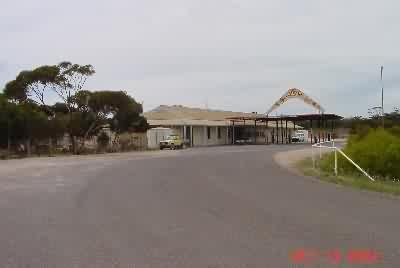
There were some Yalata around, but the staff behind the counter was the invasive species. I asked a couple questions and found out that between 300 and 400 Yalata aborigines lived on their lands (reservation = lands, tribe = community) consisting of 458,000 hectares. I don’t have my conversion from acres to hectares at top of mind, but it seems like the community has an area bigger than Alabama to live in. A few kilometers past the Yalata Roadhouse was the first paved side road I’d seen in over 1,000 kilometers. It led to the community and came with a warning.
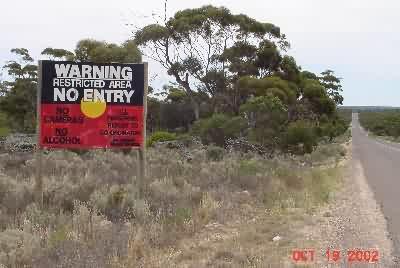
I really hoped to get a better understanding of the Aborigines, but it will take more than a casual effort. The headwind continued it’s strong harassment so I decided to settle for a very low mileage day – Nundroo. Someone had told me that along here I could see great examples of the old highway. They were correct, and for the experience I rode on it for a few kilometers.
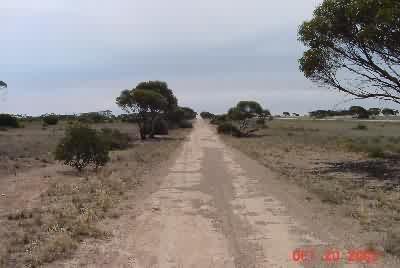
This is one hard, not smooth road. It was used as recently as 26 years ago – “The Eyre Highway: A labour force of 150 men began work on the Eyre Highway on 14 July 1941. A plough and crawler tractor were used to construct the road and then a grader followed. Enormous amounts of rubble had to be removed with shovels. The road was sealed (paved) to the border on the WA side by 1969. In 1972 the Federal Government finally agreed to provide funds in conjunction with the SA Government, and the final 400km to the border was completed and opened on 29 September 1976.”
Here’s the notice for Nundroo. As I approached this roadhouse all of a sudden planted fields appeared. See them in the background?
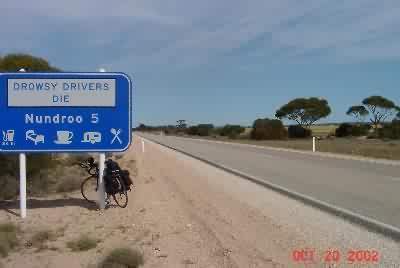
This is the first agricultural/pasture/farming thing I’d seen since the outskirts of Esperance 6 days ago. There are a lot of working windmills around, which explains the farming. And finally, the second to the last isolated (not in any town), and my vote for the most depressing roadhouse on the Nullarbor, Nundroo.
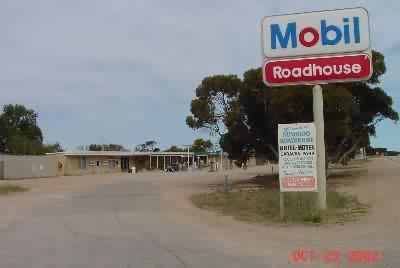
It’s obvious that Australians work hard under sometimes difficult circumstances, and I hate to kick someone when there down, but this place should be put out of it’s misery. Really. Avoid it.
I am in a tough position now. Go for average 240km days down the Eyre Peninsula to Port Lincoln, then back up to Port Augusta, then into Adelaide, or just cut across the top for much easier 180km days, but miss this section of coast. Maybe the wind will decide for me.
(Oct 20, 2002, 8:21P, Nundroo)
– Just before the Nundroo Roadhouse is the first non-roadhouse commercial establishment in 1,053 kilometers. It a combination internet station and craft shop in a ‘historic’ former one room schoolhouse. The lady there told me that the computer in was provided by the government as part of a rural access to the Internet program. She pulled the sheet off of the slow thing, booted up Windows98, and we watched it crash, a few times. I asked her if I could try switching the phone line from that machine to mine, and she said something that I equated to “go for it” and went back to sewing her crafts. I got online and sent 2 updates, but it was already after 5PM and she wanted to go home, so that was that.
– “The Dingo Fence crosses the highway 7km east of Yalata. Built to keep dingos off the vast sheep stations in SE Australia, the fence runs nearly 6,000km from the cliffs of the Bight to Jimbour in SE Queensland.” You’ve already seen pictures of these. I’ve passed I think four vermin barriers between Ravensthorpe and Nundroo.
– 1840 Edward John Eyre makes the first land crossing of Australia.
– 1912 Frances Birtles makes first crossing of Nullarbor by car.
– 1917 First train crossing
– 1976 Last 400km of Eyre Highway finally sealed (paved)

 October 19, 2002
October 19, 2002 